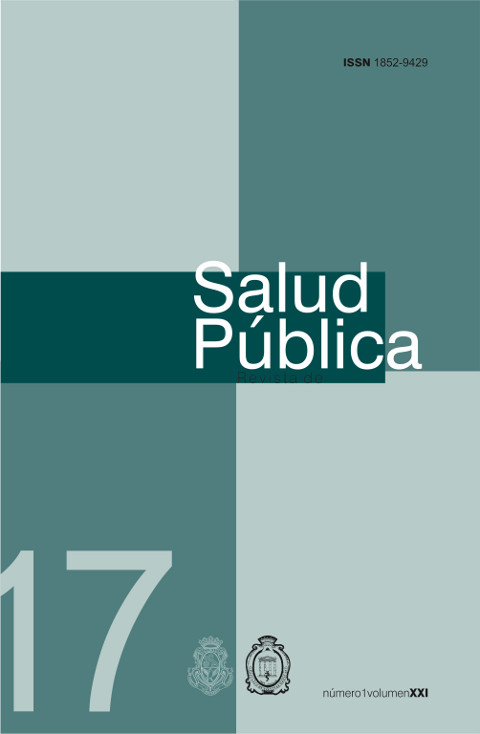SNACKS EATEN BY PRE-SCHOOL CHILDREN AND ITS RELATION TO NUTRITIONAL STATE
DOI:
https://doi.org/10.31052/1853.1180.v21.n1.15692Keywords:
pre-school children, healthy food, nutritional stateAbstract
Pre-school children eat snacks which have an important role in their feeding and influence their eating habits. Objective: To know about the selection of food eaten by pre-school children as snacks, regulated by the institution or not, and its relation to their Nutritional State. Methods: Nutritional State was assessed according to BMI/Age, the food eaten and its acceptance were registered. Chi2 Results were used: 62% of the children presented normal BMI/Age, 21% overweight, and 16% obesity. The most eaten food groups were sugar/sweets, cereals/legumes and oil/fats. Statistically, there is a significant association between acceptance of healthy food in pre-school children and the institution they attend (p<0,05). There is no statistically significant association between healthy food eaten by pre-school children and their BMI/Age (p>0,05). Conclusions: Institutions which regulate snacks try to promote healthier eating habits; however pre-school children eat a great quantity of unhealthy food, independent of their nutritional state.
Downloads
References
1. Grande MC, Román MD. Nutrición y Salud Materno Infantil. Córdoba, Argentina: Brujas; 2014.
2. Britos S, Pueyrredón P, O›Donnell A. Cap 5: Comer en una edad difícil de 1 a 4 años. En: ¿Cómo comen los niños entre 1 a 4 años en la argentina? Argentina: CESNI. 2006. [citado 30 de octubre de 2015]. Disponible en: http://www.cesni.org.ar/sistema/archivos/183-comocomenlibro.pdf.
3. Plazas M, Johnson S. Nutrición del preescolar y el escolar. En: Casanueva E., Kaufer-Horwitz M, Pérez-Lizaur AB, et al. Nutriología Médica. 3ª ed. México: Médica Panamericana; 2008. p.77-118.
4. Espínola V y Brünner M. Rol de la escuela en la formación de una alimentación sana. En su: Alimentación saludable en la escuela. Hacia una adecuada alimentación de los niños en edad escolar. 1ª ed. Ministerio de Educación. Ciudad Autónoma de Buenos Aires.2014. p. 23-30.
5. Bustos NZ. ¿Qué colación le envío a mi hijo? Revista Nutrición y Vida. Ed. Nº 8. 2014. [citado Dic 15 de diciembre de 2014]. Disponible en: http://issuu.com/carlosdonaire/docs/papel_digital_nyv_8.
6. Pineda EB, Alvarado LE. Diseño para investigación cuantitativa. En su: Metodología de la Investigación. OPS. Washington D.C. 2008. p. 79-99.
7. Sabulsky J. Selección del tipo de estudio. En su: Investigación científica en salud-enfermedad. Córdoba, Argentina: Triunfar; 2002. p. 123-165.
8. Asociación Médica Mundial. Declaración de Helsinki. Principios éticos para las investigaciones médicas en seres humanos. Helsinki, Finlandia. 1964.
9. Consejo de Organizaciones Internacionales de las Ciencias Médicas. Pautas éticas internacionales para la Investigación biomédica en seres humanos. CIOMS, Ginebra. 2002.
10. FAO (Organización de las Naciones Unidas para la agricultura y la alimentación). Guía de nutrición de la familia. Roma. 2006
11. Cameron ME, van Staveren WA. Manual on methodology for food consumption studies. Oxford: Oxford University Press, 1988.
12. Sabaté J. Estimación de la ingesta dietética: métodos y desafíos. Med Clínica (Barc), 1993; 100:591-596.
13. Carlos Aibar Remón C, Rabanaque MJ, Alvarez-Dardet C, Nolasco A, Mancho J y Gascón E. Evolución de los diseños epidemiológicos de la investigación clínica en España (1975-1994). Rev Esp Salud Pública. 1999; 73: 445-453
14. Serra M, Román B y Ribas L. Metodología de los estudios nutricionales. Actividad dietética 12 (2001): 180-184. 15. Sociedad Argentina de Pediatría. Guía para la evaluación del crecimiento físico. 3ª ed. Ciudad Autónoma de Buenos Aires, Argentina: Ideográfica; 2013. 138p.
16. Evaluación del estado nutricional de niñas, niños y embarazadas mediante antropometría. Elvira Calvo et al. 1ª ed. Buenos Aires, Argentina: Ministerio de Salud de la Nación, 2009. 144p.
17. Bustos N, Kain J, Leyton B, Vio F. Cambios en el patrón de consumo de alimentos en escolares chilenos con la implementación de un kiosco saludable. ALAN. 2011; 61(3): 302-307.
18. Crovetto M, Zamorano N, Medinelli A. Estado nutricional, conocimientos y conductas en escolares de kinder y primer año básico en 3 escuelas focalizadas por obesidad infantil en la comuna de Valparaíso, Chile. Rev chil nutr. 2010; 37(3): 309-320.
19. Coromoto Nava BM, Pérez A, Herrera HA, Hernández HR. Hábitos alimentarios, actividad física y su relación con el estado nutricional-antropométrico de preescolares. Rev. chil. nutr. 2011; 38(3): 301-312.
20. Medina Montaño R, Moreno Pérez V, Romero Velarde E. Comparación del consumo de alimentos durante el horario escolar en niños de 6-11 años de edad con sobrepeso, obesidad y peso saludable. RESPIN. 2012; 13(3).
21. Rapp, Kilian, et al. «Type of kindergarten and other potential determinants of overweight in pre-school children.» Public Health Nutrition-Wallingford 8.6 (2005): 642-649.
22. Atkin L, Davies P. Diet composition and body mass index in pre-school children. Am J Clin Nutr. 2000; 72 (1): 15-21.
23. Valdés Santillana A L. Relación entre el estado nutricio y el aporte calórico del contenido alimentario en los refrigerios de los preescolares del Jardín de niños Rosario Castellanas de la población de la 2ª Manzana Santa Cruz Tepexpan, Jiquipilco [tesis].Toluca, México ; 2013.
Downloads
Published
Issue
Section
License
Copyright (c) 2017 Escuela de Salud Pública y Ambiente. Facultad de Ciencias Médicas. Universidad Nacional de Córdoba

This work is licensed under a Creative Commons Attribution-NonCommercial 4.0 International License.
Authors who publish with this journal agree to the following terms:
- Authors retain copyright and grant the journal right of first publication with the work simultaneously licensed under a Creative Commons Attribution License which allows the work to be copied, distributed, exhibited and interpreted as long as it is not done for commercial purposes.
- Authors are able to enter into separate, additional contractual arrangements for the non-exclusive distribution of the journal's published version of the work (e.g., post it to an institutional repository or publish it in a book), with an acknowledgement of its initial publication in this journal.
- Authors are permitted and encouraged to post their work online (e.g., in institutional repositories or on their website) after the publication process. (See The Effect of Open Access). (See The Effect of Open Access).







